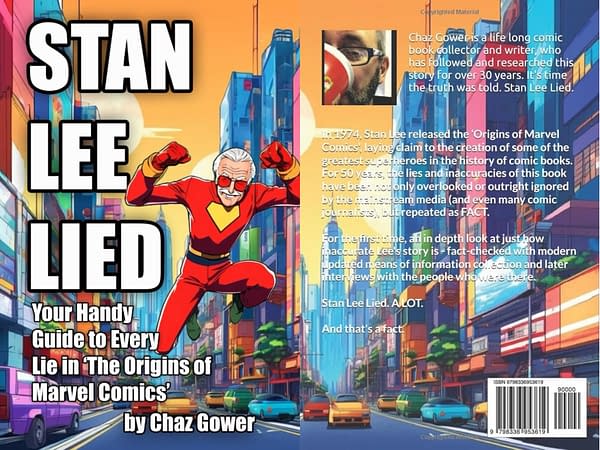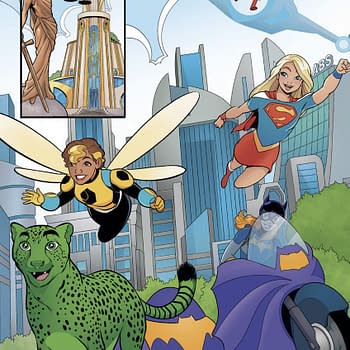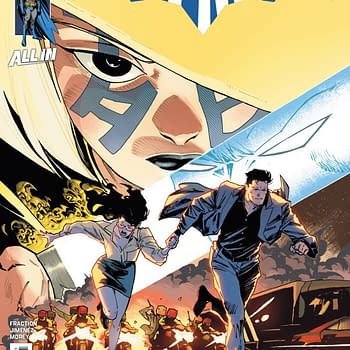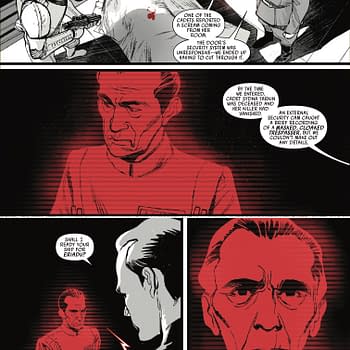Posted in: Comics, Comics Publishers, Current News, Marvel Comics, Stan Lee | Tagged: jack kirby, Stan Lee Lied
The Tears Of Stan Lee… An Extract From "Stan Lee Lied" by Chaz Gower
Yesterday, Bleeding Cool reported on a new book by Chaz Gower called Stan Lee Lied. Today we run an extract on just one of those claimed lies
Article Summary
- Stan Lee's claims about his role at Marvel are scrutinized and challenged by author Chaz Gower.
- Lee was not the head writer at Atlas/Marvel in the '40s and '50s, contrary to his assertions.
- Jack Kirby's return to Marvel is depicted as a pivotal moment that saved the company.
- Comic Book Historian Dr. Michael J Vassallo's research provides evidence against Lee's accounts.
Yesterday, Bleeding Cool reported on a new book by Chaz Gower called Stan Lee Lied. Full title, Stan Lee Lied: Your Handy Guide to Every Lie in The Origins of Marvel Comics. It takes the Stan Lee-authored Origins Of Marvel Comics currently being reissued for its fiftieth anniversary, and systematically attempts to disprove as many of the statements in that book as possible, using recorded facts and archives, testimonies and memories of others. As we reported, this is a case for the prosecution; there is no attempt to be even-handed, but we have been given an extract to reproduce to give you a flavour of the book. Bleeding Cool welcomes more perspectives from others on this issue if they wish to add them.
"Let me take you back to 1961. It's been 22 years since I first started at Timely, and I'm still editor, art director, and head writer there."
Boy, is THIS omission a doozie.
Throughout the 40's and 50's, Stan Lee was NEVER the head writer at Atlas/Marvel. His biggest claim to anything written during this time is a short stint on a horror comic called Menace – an attempt to cash in on the success of EC Comic's horror line that lasted 11 issues (Lee gave up after issue #8) – some Western genre work, and a long run on Millie the Model, where artist Dan DeCarlo did most of the work repeating the same simple type of humor stories over and over. DeCarlo's art on Millie the Model is fantastic. The stories were repetitive. (DeCarlo would leave Atlas/Marvel in 1959 and go on to a long, much loved career at Archie Comics.) Lee's writing on Menace is better, but again the artwork carried those books. Early John Romita, Bill Everett, Russ Heath, Joe Maneely… In the 40's, Al Sulman, the long time unheralded right hand for Lee, explained exactly how the process worked:
"A freelance writer had to give me an outline, like a one-page outline, of his story idea, and then I turned it in to Stan. If Stan approved the story idea, I'd follow through in giving the assignment to that freelance writer, and I'd edit the script. I made small changes that I thought would make a better script." – Al Sulman, interviewed by Jim Amash in 2009, published in Alter Ego #104, (August 2011). Sulman worked for Goodman for 17 years, from 1941 to 1958, and would leave comics after the Implosion, though he continued to edit for Goodman's Men's Magazines.
Lee was surrounded by creative people who made comics. And those comics that Marvel did (as Atlas) in the 50s were all primarily created and put together by other editors, writers and artists. Lee wrote less than 5% of that material. And again, none of it is anything that anyone notices. Issues of 'Writer's Digest' at the time show Timely (Atlas/Marvel) soliciting for stories. Comic Book Historian Dr. Michael J Vassallo, has found a number of instances where they have have these ads. Al Sulman is listed as script editor in most, and Stan Lee isn't. What Lee did do is oversee the editors who were doing the creating. He was a Goodman go-between, handling the business of making sure others were doing their job. Occasionally, he might've come up with an idea and given it to someone. From what we know, he handed out scripts to some. That's what editors do. But in general, 95% of what was done was not written by Stan Lee in that time.
In the mid-50's, based on his book, 'Seduction of the Innocent', Dr. Frederic Wertham scares enough parents to force a congressional hearing on comic books and how violent and sexual they are and claims that it leads to juvenile delinquency. Nothing is done by the government, but the publishers use it as a means to create the self-imposed Comics Code and put a great deal of smaller publishers out of business, as well as one of the biggest and most popular of all: EC Comics. Sales in the business are not the same after that. In 1957, Martin Goodman makes a critical error and switches distributors. He chooses American News Co. who he is unaware is under federal investigation. They shut down, not long after and he has nowhere to go, eventually agreeing on a deal with DC Comics to use their distribution company. (For more on this, see FANTASTIC FOUR APPENDIX 1.2 at the end of this Chapter.)
He again starts laying off staff, and relying on Lee to use freelancers to put together the books. Editors, writers and artists who'd been with Atlas/Marvel for a decade begin to go elsewhere. The Wertham scare had given comics a bad name, and sales aren't anywhere near the levels they were just 5 years ago. Lee continues to use a supply chain of stories and scripts bought through advertisements in Writer's Digest, and give as much work to the self-writing artists as he can, including his best workhorse, Joe Maneely. Maneely is one of the fastest, and most talented artists that Lee has. Tragically, In June of 1958, Maneely dies in a traffic accident and Goodman, with no faith in Lee to keep things running makes plans to shut down. The publisher is only putting out 8 books a month. In August of 1958, they release ZERO books to the newsstand.
In the door walks Jack Kirby (remember him?) who is looking for work… he immediately talks them into keeping the doors open and letting him do some sci-fi ideas – Goodman had never had much success with Sci-Fi and wasn't a fan of it – but Kirby convinces him that he can sell some books….
"Marvel was on its ass, literally, and when I came around, they were practically hauling out the furniture. They were literally moving out the furniture. They were beginning to move, and Stan Lee was sitting there crying. I told them to hold everything, and I pledged that I would give them the kind of books that would up their sales and keep them in business, and that was my big mistake." – Jack Kirby, Interviewed by Gary Groth, from The Comics Journal #134 (Feb 1990)
Years later, Lee responded to this with:
"I never remember being there when people were moving out the furniture. If they ever moved the furniture, they did it during the weekend when everybody was home. Jack tended toward hyperbole, just like the time he was quoted as saying that he came in and I was crying and I said, 'Please save the company!' I'm not a crier and I would never have said that. I was very happy that Jack was there and I loved working with him, but I never cried to him." – Stan Lee, interview by Roy Thomas, in Comic Book Artist #2 (May 1998)
Upon closer examination, who is closer to telling the truth? Well, unless you somehow missed the title of this book, it should be pretty obvious. First:
"Jack's recollection of seeing Stan crying shouldn't be dismissed out of hand. When I constructed a timeline of job numbers, I was shocked to find that Joe Maneely's last story and Jack's first story in Strange Worlds #1 ('I Discovered the Secret of the Flying Saucers!') were only a few digits apart….it made possible sense to me that if Jack had in fact arrived looking for work on the following Monday, June 10th, he would have found Stan Lee in his office inconsolable…Whatever anyone may want to say about Stan, he was very close to Maneely, had worked with him since late 1949, and depended on him to launch many/most of the Atlas character features in the western, war comics throughout the 1950s…So taking all of that together, the timing and the relationship, it is 'very' likely Jack did find Stan, not necessarily bawling his eyes out, but very upset that morning when he went in looking for work." – Comic Book Historian Dr. Michael J Vassallo, from his 'must-read' timely-atlas-comics blog.
Then when you consider… that in the month of August 1958, Marvel released ZERO books to the newsstand for the first time in their publishing history… only to see 3 new Sci-Fi Kirby books hit the stands the following month (Strange Worlds #1, Tales of Suspense #1, and Tales to Astonish #1)… it looks as if Jack's version of what happened seems much more like what actually happened. More:
"(My Dad) did feel bad for him (Lee) during those lean years for Atlas Comics because he felt the company's owner Martin Goodman was trying his best to humiliate Stan by constantly downsizing his office and his assistants, attempting to phase out the comics line altogether…" – Artist Drew Freidman, Interviewed by Chaz Gower for this book, Summer 2023
"It was just an alcove, with one window, and Stan was doing all the corrections himself; he had no assistants. Later I think Flo [Steinberg, secretary] and Sol Brodsky [production manager] came in." – Larry Lieber, Stan Lee's brother and Marvel artist.
So the truth would appear to be that after the debacle of the distribution for the company, Marvel is limited to what they can release. They just don't have the staff to do more than 8 titles a month.
( THIS is the real reason they did 8 titles a month for the first two years after the Implosion. STAFF. When Kirby came back full time, they never again did as few as 8 a month. In fact, Stan was asked numerous times before 1970 about expansion and doing more titles and his answer was always the same: "We'd love to give everybody a magazine of his own, we get requests for these things all the time, we mention in the books and I'm sure nobody believes it, we don't have the time and we don't have the staff…" – Stan Lee, Speaking Engagement at Princeton, 1966)
When Joe Maneely dies, Marvel is preparing to shut down. Martin Goodman, may or may not have had any faith in Stan Lee to save it, and/or (but most certainly) Lee just didn't have the creative means to save it… but Jack Kirby, who walked in at the perfect time, DID, and then does. Also: When Kirby last visited Marvel, before the implosion, he saw a FULL operation of company pumping out 40 books a month. Then he shows up a year after the implosion and… well Lee was down to a desk. The comics division HAD downsized considerably. So at SOME point, they were hauling furniture out of that building.
What? You want MORE proof? Is it just my OPINION that Lee had no 'creative means' to save it? Consider this: In July of 1957, when Atlas/Marvel's line of comics goes to 8, Stan Lee has a little over a year to try and create something to energize the line, before Kirby comes and saves the day. ANYTHING to try and get sales up.
The first month, he releases Cartoon Kids #1, a comic he does completely with Joe Maneely, featuring Willie the Wise Guy and Dextor the Demon (a more mean-spirited Dennis the Menace rip-off) in 20 one-page gags and 6 half page gags. It's canceled after ONE issue. Dexter the Demon #7. It was canceled after this issue. All Stan Lee and Joe Maneely. Nellie the Nurse #1, a reboot of an old series, NOT by Stan Lee, who does write this one – though most likely Bill Everett, the artist, helps. It's canceled after ONE issue. Homer, the Happy Ghost #16. This blatant rip-off of Casper the Friendly Ghost (all Stan Lee and Dan DeCarlo), would last 6 more issues, but get canceled the month before Kirby returns in the ZERO title release month of August 1958.
"Joe Maneely to me would have been the next Jack Kirby. He also could draw anything, make anything look exciting, and I actually think he was even faster than Jack." – Stan Lee, from Secrets in the Shadows: The Art & Life of Gene Colan by Tom Fields. Raleigh, North Carolina: TwoMorrows Publishing (2005)
Well, there was a full year that Lee had where he could've done anything he wanted to do, with Joe Maneely to try and save the comic book division of Goodman's business. He produced nothing of substance with Joe Maneely at all. The books that DO survive during this time are the longest running books Goodman has:
- Kid Colt Outlaw, which began in 1948 with no involvement from Lee, would last through all of this. Lee would inherit it, as there was no one else to handle it anymore, and was giving artist Jack Keller purchased scripts (mainly Joe Gill) to keep it going during this time, before taking over writing duties a few issues later.
- Millie the Model. Not created by Lee, but taken over about 20 issues into it, this is another long running Marvel title that would survive the implosion. Dan DeCarlo most likely wrote most of these, simply recopying the same gags and themes over and over.
- Miss America (starring Patsy Walker) and Patsy Walker are two more long running titles, not created by Lee, that Al Hartley has said he would both write and draw, though Lee quickly begins to sign his name as 'writer' to the stories.
"Stan Lee didn't come up with most of the ideas. He really gave me free rein. Actually, I'd just go ahead and write and draw the stories and then send them in." – Al Hartley, Alter Ego #61, August 2006
Miss America would be canceled the month before Kirby returns in the ZERO title release month of August 1958 with issue #93. Patsy Walker would survive. This is what we got. Long-time titles that would struggle to stay afloat, and Stan Lee ideas that quickly crashed and burned. In fact… Lee, on the eve of the Implosion creates two comic book ideas that immediately get canceled. We can only assume that sales were pretty horrible.
A year later, Jack Kirby shows up on the eve of the company going out of business and puts together THREE #1's: Strange Worlds, Tales of Suspense and Tales to Astonish. Two of the three become long-running books that are sales leaders for Marvel for the next few years. The evidence is pretty overwhelming that Jack Kirby is the one who saved the day.
Additional Information from the Appendix: the 8 titles a month/16 bi-monthly titles claim is a myth. Like most of the lies that Lee and Marvel have spread, it's easily disproven upon close examination. It's POSSIBLE there was an agreement. No one's ever seen it, or published it, and the FACTS as to why it isn't plausible are as follows.
From the newsstands in July of 1957, when Marvel downsized their output considerably, Millie the Model, Patsy Walker, Kid Colt Outlaw, and Miss America had four issues over those first 6 months and SEVEN issues over the first 12 months. That's more than bi-monthly. Furthermore, 1958 and 1959 are the only two years that Goodman adhered to this supposed 8 titles a month restriction. By 1961 he was averaging a little over 10 titles a month. In 1962 he averaged a little over 11 per month and in 1963 he averaged 12 per month.
As this became more well-known, over the last 20 years, adherents of the idea began to claim that DC eased up the restrictions as time went on. Wait… the reason the restrictions were put in place was because 'DC wasn't about to support its biggest and more successful rival', but as Marvel got more successful, they then allowed them to print more books? That makes absolutely no sense.
The TRUTH is, that this story is told to make it seem as though it was Stan Lee who had a plan and used his cunning and guile to navigate Marvel through the treacherous waters of Martin Goodman's clumsy business strategies. In actuality, Goodman had very little faith in Lee, and most likely it was HIM who limited Lee and the company to 8 titles per month, because there was only Lee and Brodsky to put everything together each month.
Jack Kirby came back in the summer of 1958, with 3 new books that were released in September. He didn't come back full-time until the following year, after being run out of DC by Editor Jack Schiff and deciding not to stay with Joe Simon at Archie after working on the first two Fly and Double Life of Private Strong issues.
Kirby returning full time at the end of the summer 1959, saves Goodman from again almost shutting down (zero books distributed in August of 1959) to making all of Kirby's titles MONTHLY just 9 months later. Suddenly Marvel has a writer and an artist who can produce books himself and he works fast. Oh, and he has ideas that sell. THIS is what saves Marvel Comics….
Stan Lee Lied: Your Handy Guide to Every Lie in The Origins of Marvel Comics. is published now. The Stan Lee-authored Origins Of Marvel Comics is reissued in October for its fiftieth anniversary.














